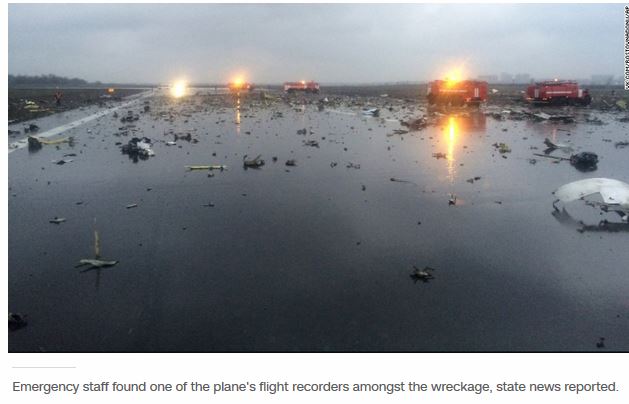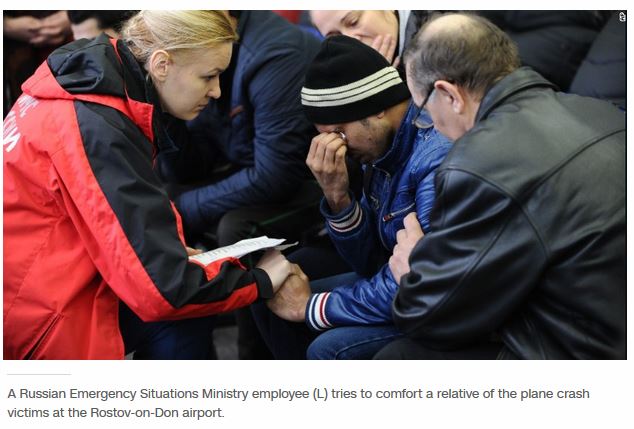After circling a southern Russian airport for more than two hours because of high ground-level winds and poor visibility, a passenger jet from the United Arab Emirates crashed during a landing attempt, killing all 62 people aboard.
The flydubai Boeing 737 took off from Dubai and was scheduled to land at the Rostov-on-Don airport at 1:20 a.m. Saturday (6:20 p.m. ET Friday), Russian Emergencies Minister Vladimir Puchkov said.
But it didn’t come down — about 800 feet from a runway — until 3:50 a.m. By that point, Russian state media reported, there were winds of about 60 mph.
Authorities have ruled out terrorism as a cause of the crash. Instead, according to investigative committee spokeswoman Oksana Kovrizhnaya, they will be looking at three possibilities: technical issues, severe weather and human error.
Kovrizhnaya said the investigations will take at least two months, as required by Russian law, but “could be prolonged,” according to state-run Sputnik news.
Investigators from UAE, U.S. to join Russian colleagues
The plane’s pilot had circled the airport hoping the weather would clear, Russia’s emergency minister said. After more than two hours, the pilot attempted to land.
Instead, the aircraft’s tail clipped the ground as it approached Rostov-on-Don’s airport, killing all 55 passengers and seven crew members.
The “main phase” of the search operation has been completed, said Vladimir Puchkov, the Russian emergencies minister, according to Sputnik news. The search operation is expected to end at 9 a.m. Sunday.
The victims’ remains have been recovered and sent for forensic analysis, he said.
The airport will be closed until Sunday, state-owned news channel Russia-24 quoted officials as saying. Until then, flights are being redirected 141 miles south to the city of Krasnodar.
Hundreds of personnel — from investigators to medics to psychologists on standby to assist grieving family members — quickly converged on the crash site, and more help is on the way.
Four investigators will be coming from the United Arab Emirates, UAE General Civil Aviation Authority official Ismail Al Hosani told reporters in Dubai.
And the U.S. National Transportation Safety Board will send a team as well, accompanied by technical advisers from the Federal Aviation Administration and Boeing.
Boeing said in a statement it will serve as technical adviser to the investigating authority in charge, the Russian Interstate Aviation Committee.
Workers at the crash scene already had both of the plane’s flight data recorders and one of two voice recorders by midday Saturday, state-run Ria Novosti reported.
4 children among victims
The UAE-based airline said 44 of the passengers were Russians, along with eight Ukrainians, two Indians and one Uzbekistani. Thirty-three of the passengers were women, 18 were men and four were children.
Flydubai insisted its primary concern was for the relatives of the victims.
“We don’t yet know all the details of the accident but we are working closely with the authorities to establish the cause. We are making every effort to care for those affected and will provide assistance to the loved ones of those on board,” flydubai CEO Ghaith Al Ghaith said.
Ghaith later told reporters the plane’s pilots were “quite experienced,” saying the Cypriot captain had flown 5,965 hours while the Spanish co-captain had flown 5,769 hours.
In another statement, the airline said it was contacting families of the victims.
“It is a process that will take a little time but as a mark of respect to the families of the bereaved, we want to make every effort to inform them directly prior to releasing the full passenger manifest,” the statement said.
Russian President Vladimir Putin expressed his deepest condolences to the families and friends of the victims, state news agency Tass reported.
Families of passengers killed will receive 1 million rubles (about $15,000) from the government, Russian state media reported. It said Sunday has been declared a day of mourning in the Rostov administrative region, which borders the Sea of Azov and eastern Ukraine.
And the UAE’s government media office posted its sympathies on Twitter, as did Dubai’s emir, Sheikh Mohammed bin Rashid Al Maktoum.
“This terrible tragedy grieves us all,” tweeted Maktoum, who is also the UAE vice president. “We mourn those lost, may their souls rest in peace.”
Airline CEO: Plane passed safety check
Ghaith, the flydubai CEO, said that, “as far as I can tell, there was no distress call,” Ghaith said.
He added that the aircraft passed a “C-Check” on January 21.
According to the Federal Aviation Administration, the aircraft maintenance inspections are graded from the least detailed and most frequent “A-Check,” to the most comprehensive “D-check,” which might occur only three to six times in a plane’s service life.
Answering a question regarding the difficulty of landing, Ghaith said “as far as we know, the airport was open and we were good to operate.”
Pilot disorientation?
CNN aviation expert Mary Schiavo said radar suggested the plane had flown three large, looping circles around the airport before it crashed.
“The poor visibility is probably the biggest clue,” Schiavo said. “But this runway was lighted, it had good lighting at one end and passable lighting at the other and it did have an instrument landing system.”
“With the clue of bad weather and making at least three different circles trying to reorient to this runway, it does look like pilot disorientation.”
Aviation safety analyst David Soucie agreed with the ministry’s preliminary assessment that weather was likely to blame.
“It’s not likely it was a mechanical failure,” Soucie said. “It’s most likely a weather-related incident.”
CNN’s Rene Marsh, Pierre Meilhan, Karen Smith, Schams Elwazer and Alla Eshchenko contributed to this report.






One Response
10 minutes before Flydubai Flight 981 was cleared for its first attempt to land, S7 Airlines Flight 1159 and Ural Airlines Flight 2758 landed successfully at Rostov-on-Don Airport. 12 minutes after Flydubai Flight 981’s first aborted landing after which it went into a holding pattern, Aeroflot Flight 1166 from Moscow Sheremetyevo made the first of three unsuccessful attempts to land at Rostov-on-Don Airport within the next 35 minutes before diverting to the nearby Krasnodar Airport, landing successfully there.
Rostov-on-Don is NOT the easiest airport to land at on an ordinary day. Pilots are advised on their charts when landing at Rostov-on-Don Airport to expect severe turbulence and possible windshear in the final moments before touchdown. It may have been the first time the pilot has been to the Rostov-on-Don Airport.
After the first attempt was aborted, the pilot flew in a holding pattern over Rostov-on-Don Airport, having circled the Rostov-on-Don Airport 10 times before attempting to land for a second time, since landings in non-designated airports are usually not welcomed by the airline management. Holding for 2 hours is ridiculous, if Flydubai policy was dictating that then I’ll never fly with Flydubai. Flydubai should have diverted after maximum 30 mins holding. The pilot could have been tired after circling over Rostov-on-Don Airport for several hours after midnight.
The pilot has flown at least three different circles trying to reorient to the runway – possibly due to”disorientation”.
According to ATC communications published online, before the Flydubai Flight 981 was established on the localiser- the instrument which indicates the center line of the runway when pilot is landing using instruments rather than visually, pilot reported to ATC that in case he would need to make another go-around, he would climb to flight level 80 (2,400 m).
The pilot then reported that he was established on the localiser and continued his descent. At 5.5 km before the runway threshold, when the Flydubai Flight 981 was at 450 m, it started climbing again. ATC records appeared to show that Flydubai Flight 981was going around moments before it crashed. The pilot reported his intention to abort the landing with “Going around, Skydubai 981”. ATC advised Flydubai Flight 981 to switch to another air traffic controller (“Skydubai 981, contact Rostov Radar on 121.2”). Flydubai Flight 981 acknowledged this with “121.2, bye-bye”, which was its final transmission.
After aborting its second approach, at an altitude of 1,230 m, Flydubai Flight 981 began a rapid descent with a vertical speed reaching more than 105 m/s and crashed and completely disintegrated about 250m short of the runway. The ball of ignited kerosine confirmed that the Flydubai Flight 981did NOT run out fuel.
Changing the “pilot flying” (PF) and “pilot monitoring” (PM) roles after the first missed approach has the advantage of the second approach being conducted by a “fresh” set of hands and mitigates the effect of the tunnel vision that often occurs after failed to land at the first attempt.
Raw data from FR24 shows the aircraft going from a 20 m/s climb to roughly a 30m/s dive within about 5 seconds. Vertical speed of over 100 m/s. If the site data is actually correct, the climb rate seems a little bit high. The pilots completely lost control during the go around and for some reason could NOT not arrest a very-steep descent.
A Boeing 737-800 “pilot flying” (PF) could inadvertently apply pressure to the control column, trip the auto flight system into CWS (Control Wheel Steering), without noticing and the pilot’s continued pressure on the stick could result in >20 degree dive.
A manually flown go-around in night / Instrument meteorological conditions and light weight can produce an inner ear acceleration illusion known as somatogravic/vestibular illusion. Longitudinal acceleration can be falsely sensed by a pilot as an extreme pitch-up. The sensation can be overwhelming and cause a pilot to ignore other sensory inputs, forcing the aircraft into a dive. This was a cause factor in
the Gulf Air Flight 072 – Airbus A320 accident in Bahrain almost 16 years ago,
the Afriqiyah Airways Flight 771-Airbus A330 crash in Tripoli almost 6 years ago and
the Tatarstan Airlines Flight 363-Boeing 737-500 crash in Kazan 2 years ago.
Similarly several US military jets were also lost during the early days of jet aircraft catapult launches from US aircraft carriers. Since instinct to push during the acceleration is uncontrollable, it is very important to have the right hand OFF the “joy-stick” during the launch. More than 12,000 US Navy aircraft were lost including the aircraft lost in combat, but most of them were lost in just attempting to take off and land on an aircraft carrier.